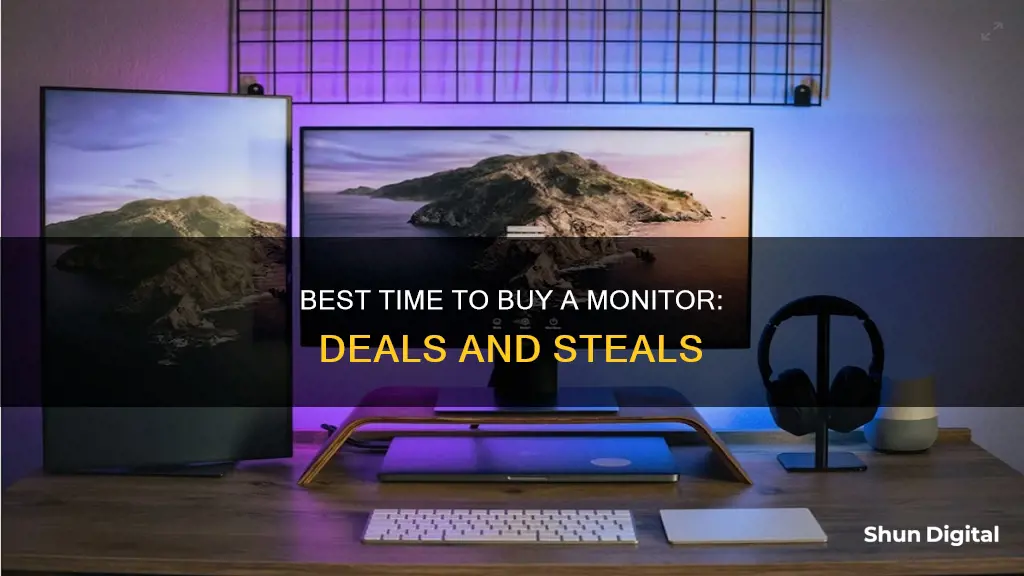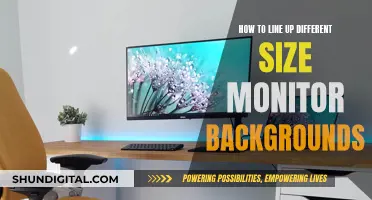
If you're looking to buy a new monitor, there are a few things you'll need to consider. Firstly, what do you need it for? Gaming monitors require fast refresh rates and low response times, while professional monitors should prioritise colour accuracy. You'll also need to think about the resolution, size, and type of monitor you want. LED monitors offer better image quality than LCD monitors, and the bigger the screen, the better – but make sure it fits your available space! If you're buying a monitor to use with another device, check that the connection type is compatible. You should also think about your budget – monitors can vary significantly in price, and some features are only available at higher price points.
| Characteristics | Values |
|---|---|
| Time of year | Black Friday, January-February, Mid-July-Mid-September, Spring/Summer |
| Purpose | Gaming, professional or general use |
| Resolution | 1920 x 1080 (Full HD) minimum; higher resolutions for sharper images |
| Size | 32 inches is plenty big; buy the biggest that fits your space and budget |
| Refresh rate | 75Hz minimum; 120Hz+ for gaming |
| Response time | Shorter is better, especially for gaming |
| Panel type | TN, IPS or VA; TN is fastest but worst for viewing angles and colour accuracy |
| Curvature | Curved monitors are more immersive and less straining on the eyes, but can be prone to glare |
What You'll Learn

Purpose: Gaming, professional or general use
When buying a monitor, it's important to first determine its main purpose. Are you a gamer, a professional, or will you be using it for general purposes?
Gaming Monitors
If you're a gamer, you should prioritize fast refresh rates and low response times. A refresh rate of 75Hz is the minimum, with most monitors designed for gaming offering at least 120Hz. The fastest available is 360Hz. As for response time, the highest you'll likely see is 5ms, while the fastest gaming monitors can go as low as 0.5ms.
You'll also want to consider the resolution. 1920 x 1080 (1080p, Full HD) is the minimum, but you'll get sharper images with Quad HD (QHD) and even sharper with 4K. For a monitor bigger than 27 inches, a resolution higher than QHD is important.
Twisted nematic (TN) monitors are the fastest and most affordable, but they have poorer image quality when viewing from a side angle. In-plane switching (IPS) monitors have slightly faster response times and better colour accuracy than vertical alignment (VA) panels, but VA monitors have the best contrast out of all three panel types.
Other features to look out for include Nvidia G-Sync or AMD FreeSync, which reduce screen tearing and stuttering, and curved monitors, which offer a more immersive experience and are said to be less straining on the eyes.
Professional Monitors
If you're a professional—a photographer, graphic designer, video production artist, etc.—you'll need a monitor designed for content creation. This means a larger screen with a resolution of at least Full HD or Quad HD for more screen space and highly detailed images. IPS panels are ideal due to their deep blacks, accurate colours, and wide viewing angles. If you're editing movies and videos, look for a monitor with a response time of 5ms or less to reduce motion blur and ghosting. An adjustable stand or dual-display mount will also come in handy for easy, ergonomic viewing.
When buying a professional monitor, it's worth investing in one that's vendor-certified as colour accurate. You'll also want calibration options, including choices for different colour gamuts, colour temperatures, and gamma curves. Flicker-free technology is another feature to look out for if you'll be spending eight hours or more in front of the screen.
General Use Monitors
If you're using your monitor for general purposes—email, social media, web surfing, etc.—you won't need a high-performance monitor with lots of extra features. Many affordable options are available, and you don't have to settle for a small screen. Even average-sized monitors (23"–24") with Full HD are likely more affordable than you think.
For everyday activities like streaming music and movies, sharing photos, videoconferencing, and creating spreadsheets, an LED or IPS monitor with Full HD resolution will work well. If you get a larger monitor (27" and up) or a touchscreen monitor, it can double as your home entertainment centre.
Holter Monitor: Uncovering Heart Health Insights
You may want to see also

Budget: How much you can spend
Budgeting is a crucial aspect of buying a monitor, as the price can vary significantly depending on the features and specifications you require. Here are some essential things to keep in mind when considering your budget for a new monitor:
Determine Your Price Range
Start by assessing how much you can realistically afford to spend on a monitor. This will help you narrow down your options and focus on finding the best value within your price range. Remember that prices can vary widely, so knowing your budget will streamline your search.
Prioritize Your Needs
Not all features are necessary for everyone. Consider what you will be using the monitor for and prioritize the features that are most important to you. For example, if you are a gamer, you might prioritize fast refresh rates and low response times, while a professional designer might require precise colour accuracy and high resolution. By understanding your specific needs, you can allocate your budget to the features that matter most.
Be Flexible with Features
Some features may be desirable, but they could be outside your budget. For instance, curved screens can provide a more immersive experience and reduce eye strain, but they also tend to be more expensive. If your budget is tight, consider which features are essential and which ones you can compromise on. You may be able to find a flat-screen monitor with excellent specifications that suits your needs perfectly.
Timing is Everything
Keep an eye out for sales and discounts, as they can provide excellent opportunities to save money. Black Friday is known for offering steep discounts on monitors, with deals ranging from budget options to high-end gaming displays. Additionally, January and February are typically good months to find deals on monitors, as companies introduce new models and clear out old inventory.
Consider Alternative Options
If your budget is limited, consider alternative options such as refurbished monitors or purchasing a large LED TV instead of a dedicated monitor. Refurbished monitors from reputable sources like Amazon can offer significant savings, and they are typically inspected and tested to ensure they are in good condition. Alternatively, a large LED TV can provide a similar experience to a monitor, and you can often find them at more affordable price points.
Monitoring Live WiFi Usage: Archer C7 Guide
You may want to see also

Resolution: 1920 x 1080 is the minimum
When it comes to monitors, resolution is a key consideration. The higher the resolution, the better the picture quality. While 4K displays offer superior visuals, a 1920 x 1080 resolution, also known as 1080p or Full HD (FHD), is the minimum you should opt for. This resolution ensures you receive a clear and detailed image without the high cost of 4K.
For graphic design or 3D modelling, a resolution of 1920 x 1080 is ideal and will provide a noticeable upgrade over lower resolutions. If you're working on complex 3D designs, this resolution is also suitable and will allow you to see your creations in greater detail.
Video editors may also find that a resolution of 1920 x 1080 is sufficient for their needs. However, if you're working with 4K footage, you may want to consider upgrading to a 4K monitor to ensure the highest quality output.
Photographers, on the other hand, should generally opt for the highest resolution they can afford. This is because photographers require an extremely detailed view of their images, and a higher resolution will allow them to see finer details and make more precise edits.
While 1920 x 1080 is the minimum recommended resolution, it's important to also consider the size of the monitor. A larger monitor with a lower resolution may result in a lower pixel density, which can impact the overall image quality. Therefore, it's crucial to find the right balance between resolution and monitor size to ensure the best viewing experience.
Salvaging a Broken LCD Monitor: Creative Solutions and Ideas
You may want to see also

Size: 32 inches is plenty 'big'
When it comes to monitor size, 32 inches is considered "plenty big". This is especially true if you're viewing the monitor from a typical desktop distance. At this size, you'll get a low pixel density if the monitor has a lower resolution.
For context, typical monitors range from 15 inches to 30 inches, with ultra-wide monitors going up to 50 inches. Creatives will generally be fine with a monitor between 27 and 32 inches. A 32-inch monitor is ideal for viewing from a typical desktop distance, and it's not hard to find a 32-inch 4K monitor for under $1,000.
If you're a gamer, a 32-inch monitor will provide a good balance between pixel density and a detailed image that isn't too demanding on your graphics card. For gaming, a QHD (2560 x 1440) resolution is a good choice for monitors up to 32 inches. This will give you a good pixel density and a detailed image without overtaxing your hardware.
Additionally, a 32-inch monitor is large enough to offer a wider layout without distortion, which can be beneficial for creatives who want to view their work without having to zoom in or scroll too much.
LCD Monitors: Virtual or Real Image?
You may want to see also

Refresh rates: 75Hz for gamers, 60Hz for non-gamers
The refresh rate of a monitor is an important consideration when buying a new one, especially if you are a gamer. The refresh rate is the number of times a screen can update in one second, measured in hertz (Hz). A higher refresh rate is associated with better video quality, reduced eye strain, and an improved gaming experience.
If you are a gamer, a 75Hz monitor is a good option. It offers a modest upgrade from the standard 60Hz, with 25% more images per second, resulting in smoother visuals and reduced motion blur. This can be beneficial in shooter and racing games, giving you a competitive edge over a 60Hz monitor. Additionally, a 75Hz monitor is more affordable than higher-end options without compromising too much on performance.
On the other hand, if you are not a gamer, a 60Hz monitor will suffice. 60Hz has been the standard minimum for decades, and it is suitable for simple games and adventure games like Minecraft, Assassin's Creed, and GTA V. You won't need an expensive video card to produce 60 Full HD frames per second with a 60Hz monitor.
It's worth noting that the higher the refresh rate, the more powerful your video card needs to be to keep up. So, if you opt for a 75Hz monitor, ensure your video card can handle the increased demand.
In summary, if you're a gamer, a 75Hz monitor will provide a noticeable improvement in your gaming experience without breaking the bank. If you're not a gamer, a 60Hz monitor will meet your needs for everyday use and casual gaming.
Differentiating Speakers and Monitors: A Quick Guide
You may want to see also







